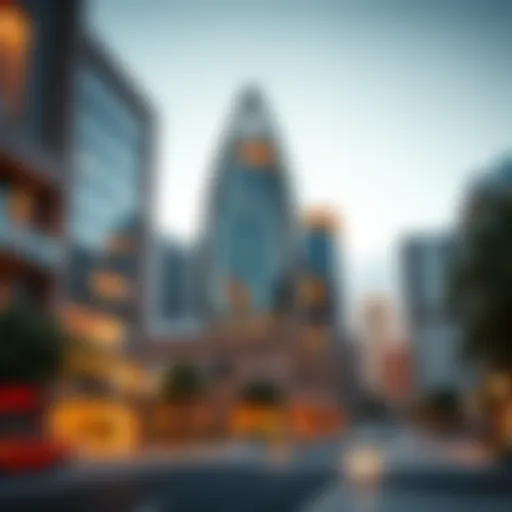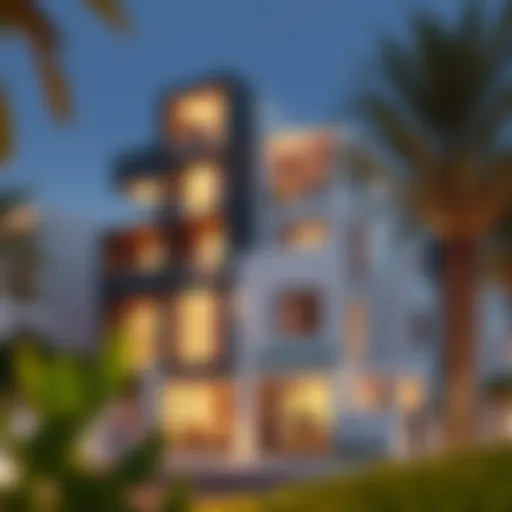Exploring the Red Line of the Dubai Metro System
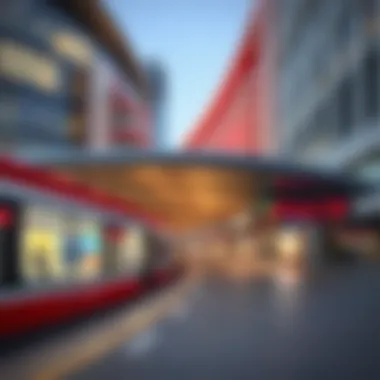

Intro
The Red Line of the Dubai Metro is not just a means of transportation; it’s a testament to the ambition and forward-thinking spirit of Dubai. Stretching across 52 kilometers, it weaves through the city, connecting bustling commercial districts to serene residential areas and capturing a slice of the diverse lifestyle that Dubai offers. This metro line serves as the backbone of the city's public transport system, facilitating the daily commutes of hundreds of thousands.
As we delve into the intricacies of the Red Line, it’s essential to consider its role beyond mere transit. It embodies the historical context of Dubai’s rapid growth, operational frameworks that define its efficiency, and the multifaceted impacts it has on the real estate landscape and urban development. Each station tells a story, and each connection made illustrates how this transportation marvel interacts with the city’s ecosystem. From the affluent area around Mall of the Emirates to the vibrant life of Deira, the line stitches together communities, transforming how residents and visitors navigate the emirate.
In this article, we will analyze distinct aspects of the Red Line, touching upon its history, operational efficiency, and its profound influence on property values and urban design. By interspersing data and real-life examples, we aim to provide a granular view of how this metro line has revolutionized mobility in Dubai and what that means for investors, property buyers, and city planners.
Let’s embark on this journey, exploring the profound impact that the Red Line has laid upon the sands of time in Dubai.
Historical Context of the Dubai Metro
The Dubai Metro has evolved into a linchpin of the city’s infrastructure, but its journey began with a vision that aligns with Dubai's rapid transformation into a global city. Understanding the historical context of the Dubai Metro means recognizing its role in shaping the urban landscape, facilitating growth, and enhancing connectivity within this bustling metropolis.
Inception and Planning
The seeds for the metro project were sown in the early 2000s, a period when Dubai was undergoing a whirlwind of developments across multiple sectors. With the city experiencing a population surge and urban sprawl, the need for a reliable public transport system became apparent. Officials understood that traffic congestion was more than an inconvenience; it was a blocker to economic progress.
The planning phase of the Dubai Metro was marked by bold ideas and meticulous research. By 2003, the RTA (Roads and Transport Authority) was established, charged with overseeing the metro's development. After extensive studies and consultations, the decision was made to employ a driverless, automated system, which was quite avant-garde at that time.
Key considerations during the inception phase included:
- Environmental Sustainability: A focus on reducing carbon emissions and promoting green commuting options.
- Economic Viability: Analysis of cost-benefit ratios to ensure financial sustainability in the long run.
- Cultural Sensitivity: Integrating the design and function of the metro with the cultural context of Dubai.
Following the planning, the highlights of this period feature various assessments and stakeholders’ engagements that paved the way for what would soon be an engineering marvel.
Construction Milestones
Once the planning laid the groundwork, construction kicked off in 2006. This phase was a feat of engineering that combined ingenuity with discipline. The Red Line was the first to be constructed, spanning approximately 52 kilometers and featuring 29 stations upon completion.
Several milestones punctuated its construction:
- Groundbreaking: Marked the start of a new era, setting the tone for ambitious infrastructure projects.
- Major Contracts: International firms were brought on board, such as Mitsubishi Heavy Industries and the Al Khaleej Contractors, who helped to bring expertise and technology to the forefront.
- Overcoming Challenges: There were significant hurdles, such as the need to manage Dubai's dense cityscape while constructing an underground metro line. However, adaptive strategies and technological innovations facilitated navigating these challenges.
These milestones not only showcased engineering excellence but also reflected Dubai’s broader ambitions to emerge as a global hub.
"The construction of the Dubai Metro is not just about transportation; it's a statement of aspiration and innovation that underpins the very fabric of urban life in Dubai."
The completion of the Red Line in 2010 served as a catalyst for ongoing developments and set a precedent for future public transport projects in the region. Through diligent planning and execution, the Dubai Metro continues to serve as a symbol of the city’s progress, highlighting its commitment to developing efficient and sustainable urban mobility solutions.
Overview of the Red Line
The Red Line of the Dubai Metro serves as a critical vein in the city’s intricate public transport system, connecting various vital areas and offering indispensable convenience to residents and visitors alike. This line facilitates easy access to both commercial hubs and residential neighborhoods, making it a preferred option for many who navigate this bustling metropolis. In this section, we’ll explore its route and overall importance, examining several components that underscore its significance.
Route Description
The Red Line stretches across Dubai, weaving through a diverse landscape consisting of urban centers, high-profile attractions, and quiet communities. It begins at Rashidiya Station, located in the eastern part of the city, and meanders its way all the way to UAE Exchange Station in the south. The total distance covers approximately 52 kilometers, dotted with strategically placed stops designed to optimize passenger accessibility.
The stops include major landmarks like the Burj Khalifa, the world’s tallest structure, and the Dubai Mall, a buzzing retail paradise that attracts shoppers from all corners of the globe. The line navigates through other key areas such as Deira and Downtown Dubai, ensuring that both leisure and commerce flow seamlessly. Each station acts as a gateway to unique experiences that Dubai has to offer, whether it's leisure, business, or culture, thereby making public transport an attractive option.
Moreover, the entire context of the route is further enriched by art installations and design elements that highlight the cultural heritage and modern identity of Dubai, transforming an ordinary commute into a fascinating journey.
Total Length and Stations
With its impressive length of around 52 kilometers, the Red Line boasts a total of 29 stations. These include, but are not limited to:
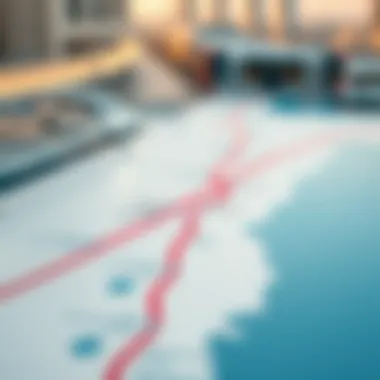

- Rashidiya Station: An effective terminus that connects commuters starting their journey in the eastern parts of the city.
- Dubai Mall Station: Adjacent to the thriving Dubai Mall, it grants visitors direct access to shopping and leisure activities.
- Burj Khalifa/Dubai Mall Station: Merging elegance and practicality, this station is ideally situated for those eager to visit the iconic tower.
- UAE Exchange Station: Functioning as a southern hub of convergence, this station enhances the District’s accessibility further.
These stations are crucial junctions, not only in supporting daily commutes but also in contributing to an efficient transport ecosystem. They facilitate smooth transfers for passengers linking to other forms of public transportation, such as buses and trams. Each station integrates well-designed facilities, including waiting areas, electronic boards for real-time train schedules, and safety features that align with modern operational standards.
In essence, the Red Line serves a vital role in the broader scope of urban mobility in Dubai. It acts as a link between various neighborhoods and commercial districts, hence stirring economic activities while promoting eco-friendly transportation. The configuration and reach of the Red Line position it as a fundamental lifeline for the thriving city.
Key Stations on the Red Line
The Red Line of the Dubai Metro is not just a mere line on a map; it's an intricately woven piece of the urban fabric of Dubai. Among the stretches of track, certain stations play pivotal roles in the spatial economy of the city. These key stations are hubs of activity, significantly influencing both local and regional dynamics. They showcase a blend of convenience, accessibility, and potential natural growth, each station contributing uniquely to the transport and urban infrastructure.
Rashidiya Station
Rashidiya Station stands as the eastern terminus of the Red Line. This station is more than a ticket stop; it's a gateway that connects suburban residents to the vibrant pulse of the city. Opened in 2010, its strategically placed location serves as a launching pad for those commuting to Dubai International Airport, making it a lifeline for travelers and workers alike.
The catchment area surrounding Rashidiya is predominantly residential, attracting families and professionals seeking affordable living options while remaining connected to the dynamic city life. Also, amenities nearby, like shopping centers and schools, make it an attractive proposition for potential buyers and investors.
"Rashidiya is where the daily grind begins for many, and its role in the community is often underestimated."
Dubai Mall Station
Next on our journey is the Dubai Mall Station. This station is not just operational; it's iconic, placed near one of the largest shopping centers in the world. The station acts as a crucial link for retail therapy enthusiasts and tourists alike. Given its proximity to landmarks like the Dubai Fountain and the Burj Khalifa, this station sees foot traffic that rivals some of the busiest transit areas globally.
Dubai Mall Station facilitates a seamless experience, providing access to innumerable dining, entertainment, and leisure options. Consequently, the surrounding areas have experienced a boom in real estate developments, bubbling up with hotels, luxury flats, and commercial buildings, each capitalizing on the high-volume visitor attraction. Investors looking at properties here may find the ROI promising due to the intense foot traffic.
Burj Khalifa/Dubai Mall Station
Last but not least is the Burj Khalifa/Dubai Mall Station. This station wasn’t merely built to support the flows of people; it’s a statement of engineering and design excellence. Tied closely to not just the tallest building in the world but also to cultural sites, this station serves as a cornerstone of Dubai's tourism, art, and retail scenes. The interior architecture and easy access through bridges and escalators add to the overall luxurious experience of the riders.
Commuters who get off here are greeted not only by stunning views but also a wide array of business and leisure opportunities. The station has a profound impact on property values in the vicinity; premium office establishments and high-end apartments have sprouted under its shadow. The mere presence of this station has transformed the area into a coveted spot for living and investment, creating a ripple effect of economic activity.
In summary, each of these key stations on the Red Line contributes to a more connected and integrated urban experience. They serve both local residents and visitors, enhancing the appeal and vitality of their surrounding environments, making them crucial focal points in urban planning and economic strategy.
Operational Framework of the Red Line
The operational framework of the Red Line is pivotal not only for its day-to-day functionality but also for understanding its role within the larger transportation ecosystem of Dubai. Quite simply, this framework ensures commuters enjoy predictable and efficient service, which is essential in a city marked by rapid growth and dynamic urban development. An effective operation protocol optimizes the connectivity and enhances the user experience, serving as a testament to Dubai's commitment to modern public transport.
Train Frequencies and Hours of Operation
The Red Line operates with a finely tuned schedule designed to accommodate the heavy passenger demand. Trains generally run every few minutes during peak hours, effectively minimizing wait times and allowing for fluid movement throughout the city. During these busy periods, frequencies can be as tight as every 2-5 minutes. Off-peak hours offer a slightly more relaxed schedule, with intervals stretching to around 7-10 minutes.
This structured timetable is backed by extensive data analytics that considers factors such as time of day, local events, and even weather patterns. This integration of technology ensures that the service remains responsive to the fluctuating needs of passengers.
The consistent operation of the metro is crucial in keeping traffic congestion down, making it a desirable alternative to the busy roads of Dubai.
The hours of operation span the whole week, with trains running from early in the morning until just past midnight on weekdays. Weekend schedules might vary slightly based on demand patterns, but service remains robust. Such comprehensive coverage allows for inclusivity, catering to both the early birds and night owls, a necessity in a city that never sleeps.
Safety Measures and Technology
Safety measures on the Red Line are designed to create a secure travel environment for all passengers. The system incorporates advanced technology that ensures both operational integrity and passenger protection. For example, surveillance cameras and emergency communication systems are strategically placed throughout the stations and within trains, allowing for constant monitoring and immediate responses to any irregularities.
In addition to physical safety, the Red Line employs state-of-the-art train control systems that automate many functions, reducing the likelihood of human error. These systems are monitored in real-time, contributing to a safe and seamless operation.
Furthermore, regular maintenance checks and updates on all equipment are conducted to maintain operational efficiency. This commitment ensures that all safety protocols are adhered to rigorously, establishing a reliable service that instills confidence in daily commuters.
As we consider the operational framework of the Red Line, we see that its shifts, schedules, and safety protocols play a critical role in shaping the ongoing appeal and functionality of Dubai’s public transportation network. The blend of technology, safety, and efficiency not only supports the daily commute but also enhances the overall image of Dubai as a forward-thinking metropolis.
By integrating these advanced operational strategies, the Red Line proves itself to be a cornerstone in Dubai’s evolving urban landscape, solidifying its importance as both a transportation option and a symbol of the city's growth.


Integration with Other Public Transport
The Red Line of the Dubai Metro stands as a keystone in the city's broader network of transportation. Its integration with other public transport systems ensures a seamless travel experience for residents and visitors alike. Understanding this integration is crucial for anyone looking to navigate Dubai effectively, whether for business, investment, or leisure.
Bus Connectivity
The Dubai Metro facilitates an extensive web of bus routes, enhancing whole transport ecosystem. The buses that connect neighboring areas to Metro stations operate with remarkable efficiency. For instance, the Rashidiya Station links directly with several bus lines, allowing commuters to transfer smoothly from rail to road. This offers a significant advantage for anyone traveling to areas that may not be directly served by the Metro itself.
Additionally, the government has prioritized synchronized schedules between buses and trains. This means that buses often arrive just in time for passengers to hop on trains and vice versa. Commuters can also leverage the Nol card system, which enables seamless payment across both buses and the metro, strengthening financial efficiency for travelers. The bus network doesn't just expand access; it actively propels economic development by ensuring various neighborhoods are accessible, effectively weaving together communities into a single, accessible fabric.
Tram Links
The tram system of Dubai complements the Red Line by covering areas that the metro does not. Notably, the trams run through the bustling areas of Jumeirah Beach Residence and Dubai Marina, providing key links for commuters heading towards the waterfront and business districts. The terminus at the Dubai Marina Mall provides a crucial access point for shoppers and tourists, integrating urban convenience with a scenic route.
Moreover, at the Dubai Mall Station, pedestrians can transfer between the metro and the tram, further reinforcing mobility options. This integration ensures that locals can hop between leisure and daily duties seamlessly, enhancing overall quality of life in the city. As tram services expand, the prospects of greater connectivity are promising and bode well for future growth.
Water Transport Options
In Dubai, water transport is not just for tourists; it serves residents as a viable transit method, particularly through the use of abras and ferries. The Red Line connects with various wharf locations, such as the Al Seef and Dubai Canal stations, making it easier for anyone wanting to cross the water quickly. Commuters can take a short transit from the Metro to a water taxi or an abra for a scenic view of the city's spectacular skyline, reducing travel times and offering a unique experience.
The integration of water transport also provides an alternative route that alleviates congestion on the roads and metro. Especially during peak hours, taking a boat can just be the ticket for efficient travel to work or leisure activities. It's an ideal solution for bustling areas where road traffic is often a headache.
This multifaceted approach to public transport reflects Dubai’s ambitious vision for a fully integrated urban transit system.
"The more thorough the cohesiveness of systems, the easier the commutes, the better the business climate, and ultimately, more vibrant neighborhoods emerge."
Significance of the Red Line in Urban Development
The Red Line of the Dubai Metro plays a critical role in shaping the city’s urban fabric. It’s not just a mode of transport; it is a catalyst for development and connectivity. This section examines how the Red Line influences urban growth, real estate values, and commercial dynamics across Dubai.
Impact on Real Estate Values
The presence of the Red Line has a pronounced impact on real estate prices in Dubai. Properties located near metro stations often command higher prices due to accessibility and convenience. For instance, the area around the Burj Khalifa/Dubai Mall Station saw significant appreciation in property values as it became a hotspot for both residents and tourists. Buyers are increasingly drawn to neighborhoods with metro access, as it reduces travel time and enhances overall livability.
When considering investment, potential buyers and developers can analyze areas based on their proximity to the Red Line. Analysts have observed that properties within 500 meters of a metro station have shown a price increase of approximately 15-20% compared to those further away. This trend isn’t just a fluke; it reflects how essential public transport links can drive demand in real estate markets. In essence, the Red Line has transformed property acquisition into more than just location; it has added a layer of strategic investment.
Influence on Commercial Growth
The commercial landscape has also felt the ripples of the Red Line’s establishment. Businesses thrive in locations that are easily reachable, and the metro has paved the way for new commercial opportunities. Shopping malls, offices, and service centers sprouted in the vicinity of the Metro’s key stations, creating bustling hubs of activity that attract foot traffic.
For example, the Dubai Mall—adjacent to the Burj Khalifa/Dubai Mall Station—has become a prime example of how proximity to the metro can benefit commercial enterprises. The constant flow of metro riders offers a robust customer base for retailers and service providers. Additionally, sectors such as hospitality have experienced growth, with hotels and restaurants strategically placed to tap into this influx of visitors and commuters.
In terms of economic development, local governments have recognized the metro’s role in improving market accessibility. They are incentivizing businesses to establish themselves near these transport nodes, leading to a diverse array of services that cater to an increasingly mobile population. Consequently, the Red Line not only promotes urban connectivity but fuels a thriving economic environment through enhanced commercial growth.
"Investing in regions connected by the Red Line is seen as a strategic move, paving the way for sustainable growth and development."
In summary, the significance of the Red Line spans beyond its immediate function as public transport. It influences real estate valuation and catalyzes commercial growth, thereby shaping the urban landscape of Dubai and reinforcing its status as a global city.
Challenges Faced by the Red Line
As the Red Line of the Dubai Metro continues to expand and serve a growing population, it faces unique challenges that can impact its overall efficiency and long-term viability. Understanding these challenges is crucial for stakeholders, including investors, urban planners, and transport authorities, as they shape the future strategies to address these issues while maintaining the line's significance in Dubai's public transport network.
Maintenance Issues
Regular maintenance is the backbone of any successful transport network. The Dubai Metro is no exception. It requires ongoing technical assessments and repairs to keep operations smooth. However, the expansive nature of the Red Line can lead to maintenance becoming a Herculean task.
Diverse climatic conditions contribute to wear and tear, demanding quick responses and proactive approaches. Dust, high temperatures, and humidity can affect both tracks and trains, resulting in potential downtime. Over time, even the best engineering solutions may falter under such environmental pressures, making routine upkeep crucial.
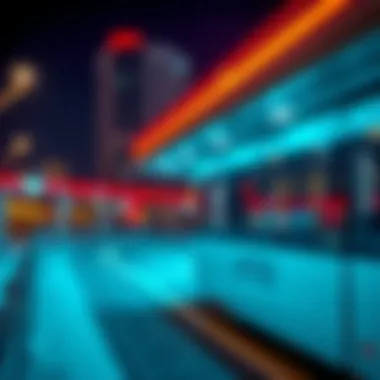

Frequent inspections and timely repairs are paramount to minimizing disruptions for commuters. Although there are scheduled maintenance periods, the challenge remains to align these with the peak hours of passenger flow, ensuring service reliability does not wane.
Moreover, there is a delicate balance between maintaining older infrastructure and implementing newer technologies. As the metro system evolves, managing retrofits or updates without disrupting service is an ongoing struggle, which requires both manpower and investment.
Capacity Constraints
With the population of Dubai steadily increasing—consider a figure like 3 million residents in the metro service area—the Red Line is often stretched thin in terms of capacity. This represents a significant challenge, particularly during peak hours when the demand for transport surges.
The current setup faces limitatons where capacity is concerned, leading to overcrowded trains and long waiting times, which can frustrate commuters. To illustrate, a train designed to carry a specific number of passengers could be routinely overloaded, resulting in uncomfortable journeys and increasing the risk of delays.
Addressing the capacity constraints is not just a matter of adding more trains; it involves a more expansive approach:
- Infrastructure Upgrades:** Introducing longer trains or expanding platforms to accommodate a larger volume of passengers.
- Increased Frequency: Shortening intervals between trains to reduce wait times.
- Smart Ticketing Systems: Implementing state-of-the-art fare collection to streamline operations.
Such measures are critical as they not only enhance commuter experiences but also ensure that the Red Line remains a viable option as Dubai continues to grow. When people feel comfortable using public transport, urban mobility improves, allowing the city to thrive sustainably.
"The success of the Red Line fundamentally relies on maintaining operational efficiency and aligning capacity with increasing demand, reflecting broader trends in urban transit systems across the globe."
In summary, the challenges posed by maintenance and capacity on the Red Line necessitate strategic planning and resource allocation. By tackling these issues head-on, Dubai can preserve the Red Line's status as an essential component of its transport infrastructure, ultimately guiding the city's ongoing development.
Future Expansion Plans
The vision for the future expansion of the Red Line is not just about adding more rails and train cars. It's about enriching the transportation experience and aligning it with Dubai's ambitious urban strategies. As the city continues to grow, the metro system needs to evolve to meet emerging demands.
This expansion plan focuses on increasing accessibility and enhancing connections between different regions of Dubai. This is vital because a well-connected transit system ensures that residents and visitors can traverse the city easily and efficiently, which adds to the overall appeal for investors and developers alike.
Potential New Stations
With expansion on the horizon, several new stations are earmarked for development. Heads are nodding in agreement as discussions swirl about the potential benefits these stations could bring to the adjacent communities. Some of the proposed stop locations include areas that currently lack robust public transport options. The anticipation is almost palpable.
- Meydan Station: Planned to service the growing residential communities in Meydan, it’s set to provide easier access to events like the Dubai World Cup, which attracts thousands of spectators each year.
- Dubai Marina Station: This station aims to enhance connectivity to the beach and the bustling marina, further appealing to tourists and residents who crave proximity to leisure and lifestyle activities.
- Healthcare City Station: With the rise of medical tourism in Dubai, a station here will connect people to hospitals and clinics, integrating health services with transport.
The introduction of these stations will not only mitigate congestion but also elevate property values in their vicinity. When you wedge accessibility into the mix, you can expect a rise in real estate demands—an attractive proposition for investors keen on maximizing their ROI.
Long-term Vision for Connectivity
The long-term vision for connectivity goes beyond just extending the rail lines. It’s about creating a comprehensive transport ecosystem that seamlessly integrates the metro with other forms of transport. The ultimate aim is to contribute to a more sustainable and efficient urban fabric.
- Smart Mobility: Focused on integrating smart technologies for efficient transport management—this includes AI-based systems for real-time tracking and coordination.
- Sustainability: Expanding the metro aligns with the UAE's sustainability goals. The metro system provides a cleaner alternative to road transport, significantly reducing carbon emissions.
- Urban Planning: New stations are also part of a larger urban development strategy, bringing in mixed-use spaces that combine housing, marketplace, and recreational areas to form vibrant communities.
"Investing in public transport infrastructure is investing in the future of urban living."
Providing a reliable and efficient transport solution will facilitate the growth of commercial and residential hubs along the Red Line, heralding a new era of urban development. As Dubai’s population continues to rise, the effective implementation of these expansion plans is essential for maintaining the city’s status as a global destination.
Finale
The conclusion of this article emphasizes the multifaceted significance of the Red Line of the Dubai Metro, highlighting its profound impact not only on urban mobility but also on economic development and real estate dynamics in the region. Throughout this exploration, we have dissected various elements that render the Red Line an essential pillar of Dubai's public transportation infrastructure.
Summary of Findings
In our detailed discourse, several key points have emerged:
- The historical context reveals the ambitious vision behind the Red Line, marking its inception and major construction milestones that have contributed to transforming Dubai's transport landscape.
- The overview of the Red Line outlines its extensive route and strategic placement of stations that cater to both residents and tourists alike, facilitating access to notable attractions and commercial hubs.
- The operational framework showcases the efficiency and safety measures taken, ensuring a seamless experience for commuters, which reflects the city’s commitment to modernity and innovation.
- The integration with other modes of transport points to a well-thought-out system designed to enhance accessibility and improve the overall commuter experience, merging buses, trams, and even water transport in a cohesive network.
- The significance in urban development is evident as we assess the rising real estate values and commercial growth spurred by the Metro's accessibility, indicating a strong correlation between public transport investment and economic vitality.
- Challenges faced by the Red Line, from maintenance to capacity constraints, are not to be overlooked, as they present ongoing hurdles that need addressing to sustain operational efficiency.
The Ongoing Role of the Red Line in Dubai’s Development
As we look ahead, the ongoing role of the Red Line continues to be a cornerstone of Dubai’s growth strategy. The plans for future expansion and further integration signal a commitment to enhancing urban connectivity. This makes it crucial not just for daily commuters but also for investors and developers who see the potential for growth surrounding the established and upcoming stations. The Red Line serves as a catalyst for future development projects, encouraging urbanization and boosting economic activity. Overall, it encapsulates the dynamic essence of Dubai—a city that thrives on innovation while embracing its roots.
By understanding the interlinked dimensions of transit and growth provided by the Red Line, stakeholders can make informed decisions in their ventures, paving the way for a more integrated and prosperous urban environment.
"Transport systems like the Red Line are not merely modes of getting from point A to point B; they are lifelines that inject vitality into urban areas and shape the very fabric of cities."
In summary, the Red Line remains instrumental not just as a transit solution but as a vital part of Dubai's identity and growth trajectory. Stakeholders should remain attuned to its developments, recognizing the opportunities and challenges that will shape the future of this vibrant metropolis.



